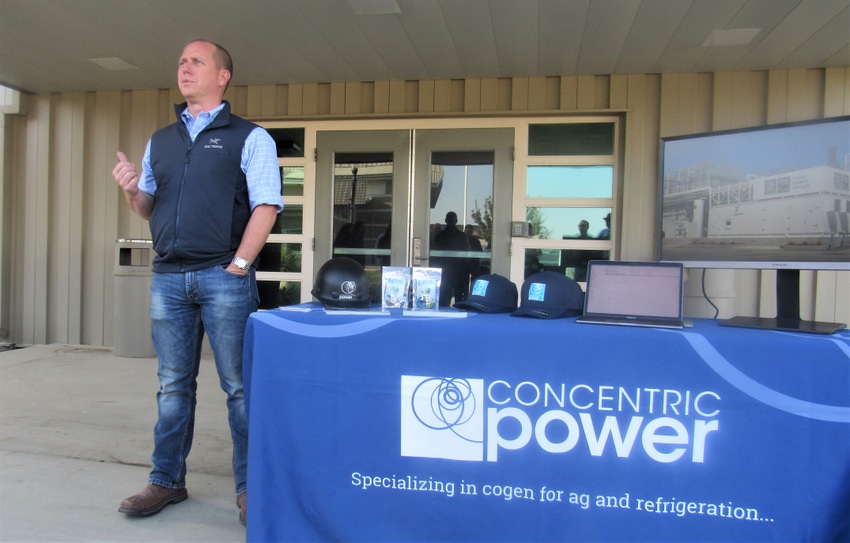
With periodic planned power outages affecting millions of Californians this fall, including many growers in rural areas, Brian Curtis’ prospects are looking up.
Eight years ago, the Salinas Valley engineer founded Concentric Power, which offers on-site cogeneration, sustainable microgrid systems and selected large-scale solar and battery storage options to provide greater energy independence to farms and industrial plants.
As the push toward sustainability has gained steam, Curtis has gathered a modest handful of agricultural customers in the Salinas and San Joaquin valleys, including the Salinas-based Taylor Farms, which credits on-site cogeneration with providing more than 70 percent of its renewable energy.
Curtis’ client list has the potential to get longer quickly, however, as high winds this fall have prompted Pacific Gas & Electric Co. to cut power to nearly 3 million Californians for up to a week at a time in some instances.
“The phone’s been ringing,” Curtis said during the fourth annual Open Farm event Oct. 23 in Tulare, Calif. “The stars are aligned for a lot of reasons.”
OPEN FARM EVENT
Curtis was one of about a half-dozen representatives of sustainability-focused startups featured at the Open Farm event, hosted by Southern California Edison and cosponsored by the Western Growers Center for Innovation and Technology, the University of California Division of Agriculture and Natural Resources, California State University-Fresno and West Hills College.
A similar event was set for Nov. 14 at West Hills’ Farm of the Future in Coalinga, Calif., featuring breakout sessions on soil amendments, hyperspectral imaging and automation.
The Tulare event began with field demonstrations by Curtis and officials from PowWow Energy, which alerts customers when dirt and dust are impeding their solar panels’ ability to capture energy; Roeloffs Solutions, a solar panel cleaning service; and WiseComm, a precision irrigation timing system.
Later, Lemoore, Calif., entrepreneur Connor Kingman described tractor implements marketed by his 2-year-old company to enable growers to turn their existing tractors or sprayers into self-driving machines, saving growers time and labor costs.
“I think this is a very exciting time for agriculture,” Kingman said. “There’s a lot of new technology that’s coming along for agriculture.”
OUTAGES HINDER AG
The Open Farm events come as many growers are grappling with forced power outages that at times slowed agricultural activities to a crawl as shuttered processing facilities caused a backup in harvests.
Industry and UC Cooperative Extension officials say the first major shutoff Oct. 9-10, which affected as many as 2 million customers statewide, closed at least a half-dozen tree nut processing facilities and also hampered wine production.
Nearly 3 million PG&E customers lost power on the weekend of Oct. 26-27, just as the Kincade Fire in Sonoma County was bearing down on wine grape operations. Though PG&E orchestrated the blackouts to avoid wildfires from downed power lines, more than a dozen active fires this fall have burned over 100,000 acres, including several blazes believed to have been started by PG&E equipment in areas not affected by the blackouts, according to U.S. News and World Report.
Among other impacts, the outages have shuttered community health clinics that many rural residents rely on for primary and emergency care, industry leaders told the Sacramento Bee. Founders of the Grass Valley, Calif.-based BoxPower, which sells solar-powered microgrids, told the newspaper they’ve been hearing from pharmaceutical and health-care organizations looking for backup power sources.
“I believe our daily inquiry rate jumped about 10 times for the first couple of days after the first power shutoffs,” BoxPower chief executive officer Angelo Campus told the Bee. “Right now, it’s at about three to four times what our average was before that.”
SELF-POWERED ‘ISLANDS’
Curtis says Concentric Power’s cogeneration, large-scale solar and battery storage products have created veritable self-powered “islands” in areas prone to short power outages such as southern Monterey County. Still, the company’s offerings are meant to complement the electrical grid; its core cogen product line includes modules ranging in size from 400 kW to 2.5 MW, which can be mixed with other sources to achieve a project capacity upwards of 20 MW, according to a news release.
Last year, Concentric teamed with an institutional fund to help customers finance $100 million in cogeneration and microgrid projects over a two-year period. Curtis asserts the next 20 years will be “transformative for how electric power is generated and consumed,” as ag and industrial consumers search for more reliable and sustainable energy sources.
“It’s an interesting time for utilities,” Curtis said. “As everything gets electrified, it just changes the dynamic of everything on the grid.”
With a push to use electricity to power everything from cars to smart phones and information systems, more pressure is placed on the grid even as natural gas plants have difficulty being approved and as nuclear power is going away, Curtis said.
“With microgrids, the private sector is going to step in for a lot of that,” he said.
The task of having to work around a shaky electrical grid is not new, Curtis said.
“You just wouldn’t expect it in California,” he said. “These are more third-world conditions.”
About the Author(s)
You May Also Like






